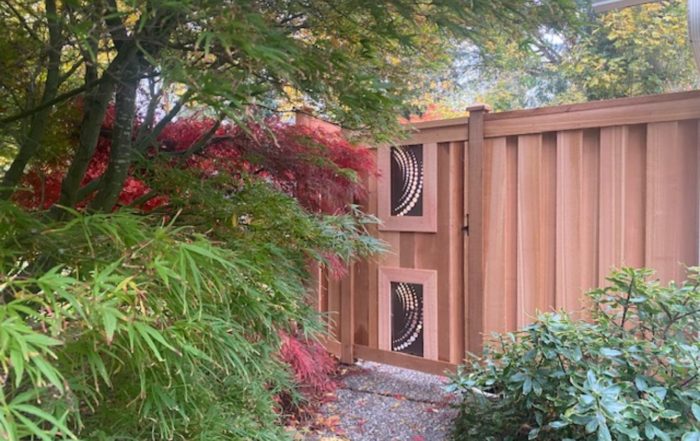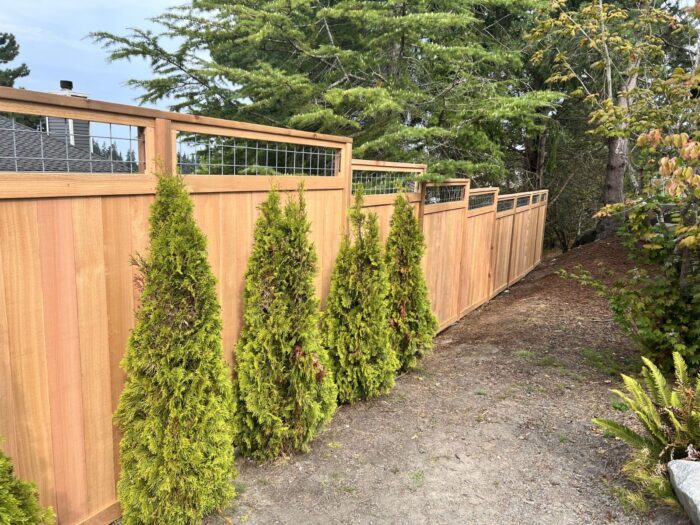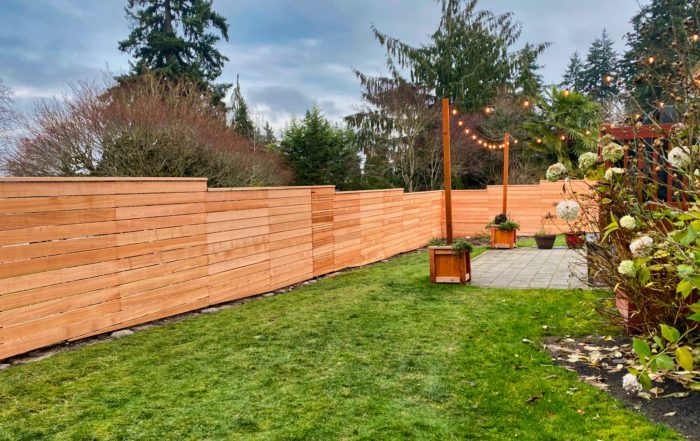Sharing a fence with your neighbors can come with many benefits-including convenience, privacy and security, but it can also be complicated if you don’t know how to go about discussing the matter with them.
Here are a few of the commonly asked questions people have about sharing a fence with their neighbor:
-Updated for 2024 –
You’ve just moved into a new house and your backyard butts up against your neighbor’s property. You want to make some improvements to the yard which may include a new fence, but you aren’t quite sure what your responsibility is to your neighbor. It’s always best to consider neighborly best practices before making a decision so everyone is happy.
Sharing a fence with your neighbors can come with many benefits-including convenience, privacy and security, but it can also be complicated if you don’t know how to go about discussing the matter with them.
Here are a few of the commonly asked questions people have about sharing a fence with their neighbor:
Does Washington State have fence laws?
Yes, Washington State does have specific laws regarding fencing. Specific state level laws are limited and generally cover broader issues like property rights. These include boundary disputes, agricultural provisions in rural areas, nuisance issues, affecting neighbors or the community, and environmental regulations.
Regulations regarding fence height, style, materials, and neighbor disputes typically fall to local city and county regulations.
Does Washington State have a Good Neighbor fence law?
Washington State doesn’t specifically have a law designated as the “Good Neighbor Fence Law.” However, the state does have regulations that address fence-related issues. These regulations can vary by locality and may be covered under different statutes. For example, the rules about boundary fences are mentioned in RCW 16.60.030, and there’s a prohibition against spite fences under RCW 7.40.030.
What is a “neighbor-friendly” fence?
Simply put, a neighbor friendly fence is constructed the same way on both sides. In other words, front and back both look the same. A less expensive option would have support posts and rough finishing on the neighbors side making for a potential eyesore.
If you’re in the market for a privacy fence, consider taking your pick of two sides. Privacy fences typically feature solid panels on one side with supporting slats on the other. Pointing to solid side outwards is not only polite, it is standard practice.
For those looking for a classic, symmetrical feel to their landscape- neighbor friendly, or good neighbor fences might be just the ticket. Stronger than standard fence construction due to its “sandwich-style” build, both you and your neighbor will get an equal view of style with no exposed link slats. Now that’s what we call true harmony!
What do I do if a neighbors new fence encroaches on my land?
Your neighbor may have built a new fence that encroaches on your property. Occasionally it is intentional but most often it is simply a mistake.
Before engaging in a full-blown dispute, make sure to find out where exactly the property line lies! Sure, most people think they know where their backyard ends and theirs begins. But from block walls to shrubs or driveways – these are notoriously unreliable markers of territory division… You’d be hard pressed not getting caught up in neighborly quarrels if the exact location of your lot isn’t established first! To avoid any differences later on down the road: seek assistance for professional surveying services as soon as possible.
If you believe your neighbor’s encroachment needs to be remedied, an amiable exchange is the best approach first. Bring up the issue in a polite manner and provide evidence like survey markers or maps that back up what you are saying. Even if it ends with going to court over this dispute, remaining respectful throughout will make all of the difference in how receptive a judge may be towards hearing out your case.
If they have agreed to remove the fence specify a date and get it in writing. If not, you’ll likely have to settle it in court. In this case it is wise to consult a lawyer to is experienced with land disputes. Be sure to have all the necessary proof including the a survey map and photos.
It is a good idea to address this right away to avoid Adverse Possession.
Can a neighbor connect to my fence?
Does Washington State have a 7-year fence law for property ownership?
The short answer is no, Washington State does not have a “7-year fence law.” What we do have are adverse possession laws, which are governed by RCW 7.28.050. Under these laws, the period typically required for someone to claim adverse possession of a piece of property is 10 years—not 7 years.
Unpacking the Intricacies of Adverse Possession
Adverse possession isn’t your everyday, garden-variety legal concept; it’s packed with layers and nuances. If you’re eyeing this route to claim ownership of land that isn’t technically yours, here’s the lowdown on what you need to check off:
- Physical Footprint: It’s essential to plant your feet firmly on the land. Virtual claims just won’t cut it.
- Ten Years, No Gaps: You need to consistently set up shop on the land—taking a break resets the clock.
- One’s Company: You’ve got to be the sole occupant. Sharing the limelight with the real owner or the public scuttles your claim.
- Visibility Factor: Your use of the land must be so evident that even a casual observer, including the rightful owner, would notice.
- Believe You’re the Boss: Your stay must be rooted in the belief that you’re the actual owner, not just a temporary squatter.
Navigating the maze of adverse possession is no walk in the park. So, if you’re wading through fuzzy property lines or disagreements, your best bet is to engage a legal pro who knows the ins and outs of Washington State real estate law.
So, the next time a fence conversation veers into “7-year law” territory, you’ll be well-armed with facts: It’s all about that 10-year threshold for adverse possession.
How to build a fence legally in Washington State?
Washington State requires you accurately know your property line which may require a survey. You are also required to inform your neighbors in writing of your intent to build a fence. If part of a Home Owners Association you will need to check the HOA rules regarding any requirements. No permit is required if your fence is 6ft or lower. Taller fences require a permit.
Who pays for fence between neighbors Washington State?
Under RCW 16.60.030, if two neighbors share a fence line and one of them needs a fence for their property’s protection, the other neighbor must help build it. Once notified, the other neighbor is responsible for constructing half of the fence, as close to the property line as possible.
However, it’s important to discuss and agree on this arrangement with your neighbor before any construction starts.
What if I build a fence on a boundary line and my neighbor uses it to enclose their land?
If you use your neighbor’s fence as part of your own enclosure, you need to pay them for half of its value. This is according to the law in RCW 16.60.020. However, if the fence has special materials like hog wire, you only need to cover the extra cost if you’re also using hog wire for your fencing.
For example, imagine your neighbor, Bob, built a fence on the boundary line of his property. Later, you decide to enclose your yard and end up using part of Bob’s fence as one of your boundaries. In this case, you’d need to pay Bob for half the value of the portion of the fence you’re using. But if Bob’s fence had special hog wire and you didn’t use hog wire for your side, you wouldn’t have to pay for the extra cost of the hog wire unless you also chose to use hog wire for your enclosure.
However, it’s important to be aware of any local building codes and regulations that may come into play when sharing the cost of construction. Additionally, it’s always helpful to have a written agreement between you and your neighbor outlining the terms of the fence-building project.
What happens if my neighbor won’t pay for their half of the fence?
According to RCW 16.60.040 If you’ve told your neighbor that a fence needs to be built and they’ve had enough time to do their part but haven’t, you can go ahead and build the whole fence yourself. After that, you can legally ask them to pay back half of the fence’s cost.
Is a fence required between properties?
Washington State residential fence laws do not require a fence to be built between properties. There are some exceptions including the presence of an animal that requires containment or the property has a pool or spa.
What are the local laws regarding dogs and sharing a fence with your neighbor?
In Washington state, there are no specific laws that specifically address dogs and sharing a fence with your neighbor. However, there are some general guidelines and practices you can keep in mind to navigate this situation harmoniously.
When it comes to dogs, it’s essential to consider their safety and well-being. Make sure the fence you build or share with your neighbor is pet-friendly and can effectively contain your animals. If your dogs are known to be escape artists or have specific needs, communicate this with your neighbor so that they understand the importance of a secure fence.
If any disputes arise between you and your neighbor regarding the fence or dogs, it’s advisable to try to resolve them amicably through open dialogue and compromise. If necessary, you can seek legal advice or mediation services to help find a resolution that works for both parties.
Finally, while you are not required to build a fence for your dog, there are some very definite laws regarding dog bites and liability for injuries caused by dogs.
Remember, this is just a simplified summary. For all the nitty-gritty details and advice, it’s best to consult the actual laws and maybe even chat with local authorities or legal experts.
What are the requirements for a fence if the property has a pool or spa?
For safety reason Washington state law requires a fence at least 48″ high completely enclosing the pool or spa with a self closing, and self latching gate. Additionally, the latch must not be in reach of children.
Are spite fences legal?
Per RCW 7.40.030 Washington State law prohibits the construction of any fence meant to spite, or annoy a neighboring landowner.
Are there regulations on height and placement?
Washington State does not have any specific laws regarding height restrictions. The state does however require a building permit if the fence is over six feet tall. Refer to Washington State Building Code Guidelines: WAC 51-16-080
While state regulation of fence height may be limited there are local city and county laws to consider. Generally speaking, residential fences should be no more than six feet high, with an additional two feet of architectural embellishments such as lattice. Additionally, if your property is situated on a slope or near a street-corner, then you may need to get permission from your local government before building the fence. Finally, you should always check with your neighbor to make sure that they are comfortable with the height and location of the Pacific Northwest fence.
Exact height and placement restrictions will vary by city.
Sound confusing? Not to worry, an experienced local fence builder will know all the rules and regulations.
Can my neighbor remove my fence without asking?
If professionally built and within your property lines it would likely require a court order. Pacific Northwest property owners should check with their local government to find out the regulations for removing a fence. Generally, both neighbors must agree to remove the existing fence and any other permanent structures from the property line. Additionally, it’s important to make sure that you get written consent from your neighbor before taking down the Pacific Northwest fence. Finally, it’s always helpful to have a written agreement between you and your neighbor outlining the terms of the fence-removal project.
Are there tree trimming rules?
Typically, the property owner can trim branches off a neighboring tree if they are encroaching on their property line. However, if the trimming kills, or irreparably damages the tree the property owner may be held liable for timber trespass per RCW 64.12.030.
Can I build an adjoining fence?
When Pacific Northwest property owners are looking to build a fence that adjoins their neighbor’s, it’s important to consider all of the variables before getting started.
While boundary fences may require an agreement with your neighbor as it is built directly on the property line you can build a non-boundary fence so long as it is on your side of the property line. Non boundary fences are typically required to be between 2 and 8 inches from the property line depending on your area.
Pacific Northwest regulations require that fences be no more than 6 feet in height, with an additional 2 feet for ornamental decoration, and should not obstruct views from neighboring properties.
What is the etiquette for fence maintenance?
Taking good care of your fence isn’t just a neighborly move – it’s essential to maintain an aesthetically pleasing and functioning outdoor area. To ensure you can enjoy “the great outdoors” with peace in mind, be sure to regularly paint, repair, treat and stain the wood on your property line as needed. And don’t forget about pets who may leave their own special mark! If all this upkeep sounds like more than you bargained for when installing your fence try materials that require minimal maintenance so family time is reserved only for fun times (and not sanding or staining!).
Resources:
Washington State property laws regarding fences




